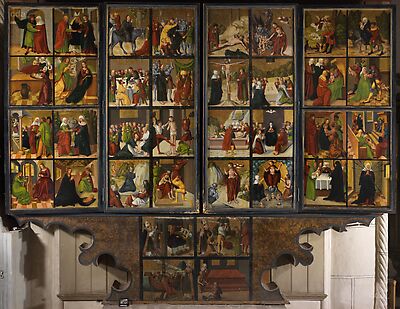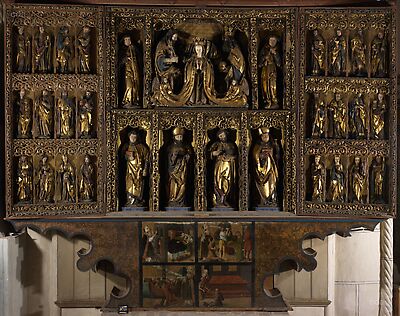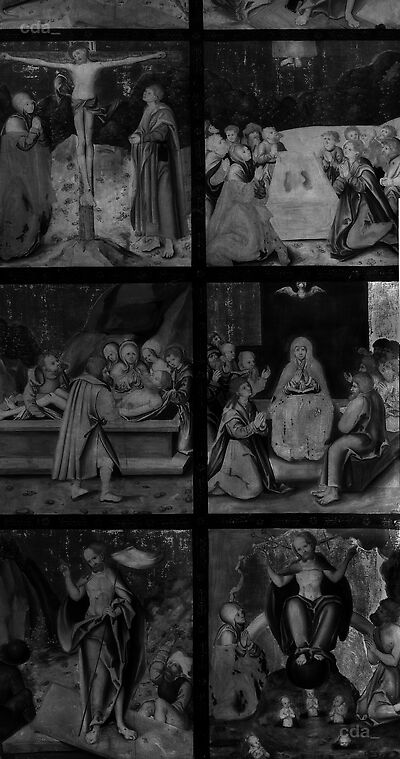Right inner wing, verso: The Nailing on the Cross, Christ on the Cross, The Entombment; The Resurrection; The Descent into Purgatory; The Ascension; Penticost; the Last Judgment.
For the Passion cycle the Carrying of the Cross is usually chosen as the image that precedes the Crucifixion. The cycle in Bernau
Right inner wing, verso: The Nailing on the Cross, Christ on the Cross, The Entombment; The Resurrection; The Descent into Purgatory; The Ascension; Penticost; the Last Judgment.
For the Passion cycle the Carrying of the Cross is usually chosen as the image that precedes the Crucifixion. The cycle in Bernau abandons this popular motif in favour of the much rarer scene shown: the gospels do not describe the Nailing on the Cross in preparation for the Crucifixion. However, this scene was always included in the Passion Cycles in 15th century illustrated books[...], which may have provided the inspiration for this panel. The cross is positioned at an oblique angle on the ground in a rocky landscape. The naked figure of Christ is already bound to the cross with a rope and his robe lies on the ground beside him. There is also a box of tools and one of the henchmen cropped by the right edge of the painting strikes the first nail into Christ's hand. An elegantly dressed man in a turban gives the orders.
Second scene: A crowded scene with the two thieves' crosses is not shown here, but rather just the Virgin and St John standing in mourning beneath Christ's cross. It is a repetition of the well known almost stereotypical group. [...] But of greater interest is the fact that this Crucifixion scene contains elements from early woodcut illustrations that may have served as a prototype for the artist working on this panel.
Third scene: Christ's corpse rests on a linen cloth and is placed in the sarcophagus by three men. The young man can be recognized as the favoured disciple John, while the two bearded men are Joseph of Arimathia and John Nicodemus. The Gospels of Mark and Luke mention two women who were present at the entombment. Here the Virgin is shown with folded hands together with another woman wearing a head scarf. A third woman, the penitent sinner Mary Magdalene, is shown in a wide dress and a fashionable Renaissance bonnet.
Fourth scene: The core of Christian faith, the resurrection of the crucified Christ from the dead on the third day after his crucifixion and entombment, is not directly mentioned in the gospels. [...] On the panel in Bernau this scene is reduced to three people. The Risen Christ stands on the diagonally placed lid of the sarcophagus, wearing a purple robe and visibly displaying his stigmata. In his left hand he holds the victory banner and raises his right hand in blessing. One of the watchmen is sleeping, while the other looks up at Christ with raised arms. The rocky landscape in the background provides a frame for the figure of Christ.
Fifth scene: According to biblical accounts Christ descended into Hell after his death. The brief account in Matthew 12, 40 and 27, 51 is expanded on in the Golden Legends and in the Apocrypha Gospel of Nicodemus. [...] On the panel in Bernau Christ stands opposite a group of kneeling, naked children at the open door of Hell. He is shown liberating the victims of the massacre of the innocents from the influence of Hell rather than the first ancestors. Hell is represented by a flaming monster and a small beast-like devil.
Sixth scene: The Gospels of St Mark 16, 19 and St Luke 24, 18 as well as the Acts of the Apostles 1, 9 recount how on the 40th day after Easter Christ was hidden by a cloud while his disciples watched. Here the artist has shown the group of apostles kneeling in prayer around a stone shaped like a sarcophagus. All that remains of Christ are his footprints and only the feet and the hem of the ascending figure are visible at the top edge of the panel. The Virgin is also present and is set opposite the favoured disciple John in the foreground.
Seventh scene: According to Luke 24, 49 and John 14, 26 and 15, 26 Christ had announced the advent of penticost to the disciples. In the Acts of the Apostles the miracle is described as a wind that filled the house where the apostles were gathered and that tongues of fire appeared over their heads. Here the artist has as was common in late gothic art place the Virgin who is not mentioned in the gospels at the centre of the scene. The Holy Spirit hovers above her head in the form of a dove and the disciples are shown seated with expressions of amazement on their faces. St John is positioned prominently in the foreground with his head bowed in prayer.
Eighth scene: Wearing the red robe of a judge Christ sits enthroned on a rainbow surrounded by clouds. His feet rest on a glass globe and he demonstratively displays the stigmata on his raised hands. A sword and a lily are shown coming out of his mouth. These according to John 1, 16 and 2, 16 represent divine wrath and grace. On one side the Virgin and St John the Baptist are shown kneeling and interceding for mankind on the day of the Last Judgment when Christ appeared as the judge of the world to assess the living and the dead according to their deeds. The resurrection of the dead is visible on the ground below. Here they are shown as praying children who rise directly out of the ground. [...] This panel is the last in the in the cycle of the Life of Christ.
[Sachs 1989, 67- 80]
Recto: carved figures
- Attributions
-
Follower of Lucas Cranach the Elder
Anonymous Master from the Cranach Workshop
Attributions
| Follower of Lucas Cranach the Elder | [cda 2016] |
| Anonymous Master from the Cranach Workshop | 'unknown, formal member of the Cranach Workshop' |
- Production date
- about 1515-1519
Production date
| about 1515-1519 | [cda 2017] |
- Dimensions
- Dimensions including frame: 282 x 128.5 cm
Dimensions
Dimensions including frame: 282 x 128.5 cm
[Heydenreich, cda 2016]
- Signature / Dating
None
- Owner
- St. Marien zu Bernau
- Repository
- St. Marien zu Bernau
- Location
- Bernau bei Berlin
- CDA ID
- DE_StMB_NONE-001b
- FR (1978) Nr.
- FR-none
- Persistent Link
- https://lucascranach.org/en/DE_StMB_NONE-001b/
![The Bernau Altarpiece [right inner wing]: Passion of Christ [verso]](https://lucascranach.org/imageserver-2022/DE_StMB_NONE-001b_FR-none/01_Overall/DE_StMB_NONE-001b_FR-none_2016-02_Overall-s.jpg)
![The Bernau Altarpiece [left inner wing]: Passion of Christ [verso]](https://lucascranach.org/imageserver-2022/DE_StMB_NONE-001a_FR-none/01_Overall/DE_StMB_NONE-001a_FR-none_2016-02_Overall-s.jpg)
![The Bernau Altarpiece [left alteration wing]: Live of the Virgin [recto], Live of Saints [verso]](https://lucascranach.org/imageserver-2022/DE_StMB_NONE-001c_FR-none/01_Overall/DE_StMB_NONE-001c_FR-none_2016-02_Overall-s.jpg)
![The Bernau Altarpiece [right alteration wing]: The childhood of Christ [recto], Live of Saints [verso]](https://lucascranach.org/imageserver-2022/DE_StMB_NONE-001d_FR-none/01_Overall/DE_StMB_NONE-001d_FR-none_2016-02_Overall-s.jpg)
![The Bernau Altarpiece [left side wing]: The Golden Legend (Aurea Legenda)](https://lucascranach.org/imageserver-2022/DE_StMB_NONE-001e_FR-none/01_Overall/DE_StMB_NONE-001e_FR-none_2016-02_Overall-s.jpg)
![The Bernau Altarpiece [right side wing]: The Golden Legend (Aurea Legenda)](https://lucascranach.org/imageserver-2022/DE_StMB_NONE-001f_FR-none/01_Overall/DE_StMB_NONE-001f_FR-none_2016-02_Overall-s.jpg)
![The Bernau Altarpiece [predella]: St Nicholas legend](https://lucascranach.org/imageserver-2022/DE_StMB_NONE-001g_FR-none/01_Overall/DE_StMB_NONE-001g_FR-none_2016-02_Overall-s.jpg)


